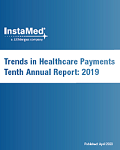 By Deirdre Ruttle, Chief Marketing Officer, InstaMed
By Deirdre Ruttle, Chief Marketing Officer, InstaMed
Twitter: @InstaMed
Twitter: @deirdre_ruttle
The idea of a largely digital world is no longer a far off fantasy. It is today’s reality. Digital adoption is expected to continue growing as precautionary guidelines related to COVID-19 encourage limited in-person interactions whenever possible. Last year the Pew Research Center reported that 9 out of 10 Americans were online. The report went on to share that 8 out of 10 owned a smartphone, making digital interactions easier than ever using apps, mobile wallets and various communication services.
With that many Americans holding gateways to the internet in the palms of their hands, it is no surprise that 65 million consumers were active participants in the on-demand economy in 2019 (Rockbridge). This on-demand economy is built on the simple convenience of secure transactions and interactions that are easy to understand. The Trends in Healthcare Payments Tenth Annual Report: 2019 shared that 84% of consumers already pay their non-healthcare bills online. Consumers have come to need the same convenient, easy to understand and secure transactions and experiences in healthcare payments as well.
Though they are rising at a slower rate than twenty years ago, when compared to wage increases and inflation, healthcare costs and ultimately consumer payment responsibility remain high. Families covered a third of healthcare costs in 2019 that included premiums and out-of-pocket costs at an estimate of $28,386 (Milliman Research Report). Today’s consumers are aware and apprehensive. 73% are concerned about their ability to pay medical bills (The Physicians Foundations).
Paper-based legacy payment practices can be costly for providers from an administrative perspective and can lengthen the collection process as consumers decipher their bills and submit payment in manners that are not immediate. Most consumers are confused by the explanation of benefits from their health plans and 70% reported confusion around their medical bills, fueling uncertainty about payment responsibility. Additionally, 91% of consumers noted that they were surprised by a medical bill last year due to higher than expected balances (Trends in Healthcare Payments Tenth Annual Report: 2019).
To deliver favorable consumer experiences and achieve a more streamlined collection process, providers must consider meeting today’s consumers where they are by implementing the digital payment experiences they demand.
Here are a few ways to bring positive payment experiences through digital interactions.
eStatements allow access to bills online. Payments can be made digitally without mailing a check. Consumers can view their payment responsibility and reconcile their bills easily. Payments can be collected without processing by back-office staff.
Online patient portals empower consumers to take control of their payment experience in a completely self-service capacity. They can view their patient accounts while making payments quickly and conveniently without visiting a location.
Automated payments allow payments to be collected with minimal effort from either the provider or the consumer. A consumer’s payment information is securely and compliantly stored within their provider’s system to be processed upon service completion.
This article was originally published on InstaMed and is republished here with permission.
 For the past decade, the Trends in Healthcare Payments Annual Report has been published for the purpose of objectively educating the market and promoting awareness, change and greater efficiency. These trends highlight quantitative data derived from the InstaMed Network and feature qualitative, proprietary, independently gathered survey data from consumers, providers and payers nationwide. Trusted third-party sources are also used to analyze the market from the perspective of all stakeholders – consumers, providers and payers. Learn more, download the report.
For the past decade, the Trends in Healthcare Payments Annual Report has been published for the purpose of objectively educating the market and promoting awareness, change and greater efficiency. These trends highlight quantitative data derived from the InstaMed Network and feature qualitative, proprietary, independently gathered survey data from consumers, providers and payers nationwide. Trusted third-party sources are also used to analyze the market from the perspective of all stakeholders – consumers, providers and payers. Learn more, download the report.
